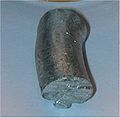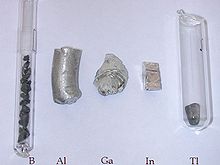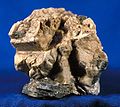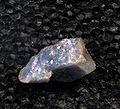Boron group
The boron group (also Triele) is the 3rd main group (according to the new numbering of the IUPAC group 13) of the periodic table. It contains the elements boron (B), aluminium (Al), gallium (Ga), indium (In) and thallium (Tl). The artificially produced radioactive element nihonium (Nh), formerly also called "eka-thallium", is also included.
In former times, all elements of the boron group were partly called earth metals, derived from the alumina, an aluminium oxide (Al2O3). However, since boron itself is not counted among the metals but among the semimetals, today only the other elements of the boron group are called earth metals.
· 
Boron
· 
Aluminium
· 
Aluminium foil (99 % Al content)
· 
Gallium
· 
Gallium crystal (99.999 % Ga content)
· 
Indium
· 
Indium wire
· 
Thallium

The boron group
Occurrence
The earth's crust consists of 7.3 % elements of the boron group, which are mostly present as oxides. Aluminium, the most common metal in the earth's crust, accounts for 99.94 % of this. The other elements of the boron group are rare.
This 0.06% is broken down as follows:
- 51 % Boron
- 46 % Gallium
- 3 % Indium
- 0,2 % Thallium
Minerals containing aluminium:
· 
Bauxite (mineral mixture)
· 
Corundum (Al2O3)
· 
Ruby (form of corundum)
· 
Raw sapphire (form of corundum)
No element of the boron group makes a solid appearance.
Properties
The first element of the group, boron, differs substantially from the other elements of the boron group because of its semimetallic properties, all of which are metals and similar in properties to the alkaline earth metals.
Physical properties
With increasing atomic number, atomic mass, atomic radius and ionic radius increase. Boron has the highest melting point with 2076 °C, gallium the lowest with only 29.76 °C (body temperature: ~37 °C). In between are indium (156.6 °C), thallium (304 °C) and aluminum (660.32 °C). The boiling points decrease from top to bottom: Boron has the highest value at 3927 °C, followed by aluminium (2467 °C), gallium (2204 °C), indium (2072 °C) and finally thallium (1473 °C).
As the atomic number increases, the density increases, while the hardness decreases. Boron has the lowest density of 2.460 kg/dm3 and the highest Moh's hardness of 9.3. Thallium has exactly the opposite density of 11.850 kg/dm3 and a Moh's hardness of only 1.2.
Aluminium has the highest electrical conductivity at 37.7 MS/m (about one third less than copper (58 MS/m)), while boron has the lowest at 0.10 mS/m.
The 1st ionization energy decreases with increasing atomic number from 8.298 eV for boron to 5.786 eV for indium, but gallium is second with 5.999 eV (instead of aluminum with 5.968 eV). Thallium has an increased value of 6.108 eV.
The electronegativity is highest with boron at 2.0, reaches a temporary low point at 1.5 with aluminium and then rises again to 1.8, the value of gallium. In the further course, the electronegativity decreases again to the value 1.4 (thallium).
At very low temperatures, aluminium, gallium, indium and thallium conduct electric current without resistance. They become superconductors.
| Item | Melting point in K | boiling point in K | Density in kg/m3 | Mohs hardness | El. conductivity in S/m |
| Boron | 2349 | 4200 | 2460 | 9,3 | 1 · 10−4 |
| Aluminium | 933,47 | 2740 | 2700 | 2,75 | 37,7 · 106 |
| Gallium | 302,91 | 2477 | 5904 | 1,5 | 6,76 · 106 |
| Indium | 429,75 | 2345 | 7310 | 1,2 | 11,6 · 106 |
| Thallium | 577 | 1746 | 11850 | 1,2 | 6,17 · 106 |
Electron configuration
The electron configuration is [X] ys2yp1. The X stands for the electron configuration of the noble gas one period higher, and for the y the period in which the element is located must be inserted. Starting with gallium, there is also a (y-1)d10 orbital; and starting with thallium, there is also a (y-2)f14 orbital.
For the individual elements, the electron configurations are:
- Boron: [ He ] 2s22p1
- Aluminium: [ Ne ] 3s23p1
- Gallium: [ Ar ] 3d104s24p1
- Indium: [ Kr ] 4d105s25p1
- Thallium: [ Xe ] 4f145d106s26p1
- Nihonium (calculated): [ Rn ] 5f146d107s27p1
The oxidation state is +3. Only thallium and indium also occur with the oxidation state +1, which in the case of thallium is even more frequent than +3.
Chemical reactions
In the following equations the Me stands for an element from the third main group (boron group).
- Reaction with oxygen:
Thallium also forms Tl2O
- Reaction with hydrogen (not spontaneous):
Only boron and aluminium react to form (always covalent) hydrogen compounds. In the case of boron, the structurally diverse boranes with diborane (B2H6) as the simplest representative are formed by three-centre bonding; the hypothetical monomer BH3 does not exist. AlH3 molecules are connected by hydrogen bonds.
- Reaction with water:
Only aluminium releases hydrogen from water. On contact with air/oxygen, however, aluminium very quickly forms a passivation layer which protects the metal from reacting with water.
- Reaction in alkaline:


In the alkaline, no Al(OH)3 is formed, but the aluminate ion Al(OH)4-.
- Reaction with halogens (using chlorine as an example):
Thallium also forms TlCl.
Questions and Answers
Q: What is the boron group?
A: The boron group, also known as Group III and Group 13, is a group of elements on the periodic table.
Q: Are most members of the boron group metals or non-metals?
A: Most of its members are poor metals, except for boron.
Q: What is the classification of boron in the boron group?
A: Boron is a semimetal.
Q: Are all elements in the boron group metals?
A: No, the rest of the elements are soft metals.
Q: Can boron be classified as a metal?
A: No, boron is not a metal but rather a semimetal.
Q: What is the main element in the boron group?
A: The main element in the boron group is boron.
Q: Is boron the only non-metal element in the boron group?
A: Yes, boron is the only non-metal element in the boron group.
Search within the encyclopedia




